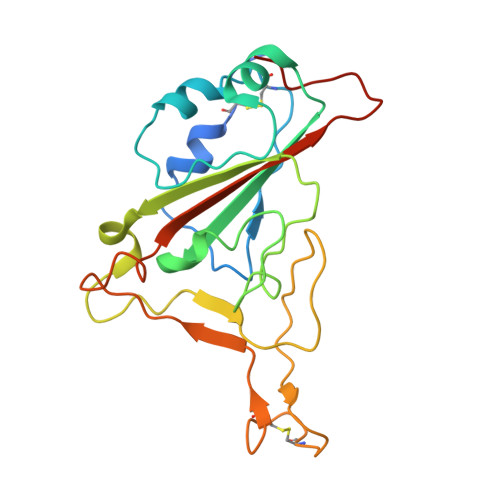Characterization and structural basis of a lethal mouse-adapted SARS-CoV-2.
Sun, S., Gu, H., Cao, L., Chen, Q., Ye, Q., Yang, G., Li, R.T., Fan, H., Deng, Y.Q., Song, X., Qi, Y., Li, M., Lan, J., Feng, R., Guo, Y., Zhu, N., Qin, S., Wang, L., Zhang, Y.F., Zhou, C., Zhao, L., Chen, Y., Shen, M., Cui, Y., Yang, X., Wang, X., Tan, W., Wang, H., Wang, X., Qin, C.F.(2021) Nat Commun 12: 5654-5654
- PubMed: 34580297
- DOI: https://doi.org/10.1038/s41467-021-25903-x
- Primary Citation of Related Structures:
7FDG, 7FDH, 7FDI, 7FDK - PubMed Abstract:
There is an urgent need for animal models to study SARS-CoV-2 pathogenicity. Here, we generate and characterize a novel mouse-adapted SARS-CoV-2 strain, MASCp36, that causes severe respiratory symptoms, and mortality. Our model exhibits age- and gender-related mortality akin to severe COVID-19. Deep sequencing identified three amino acid substitutions, N501Y, Q493H, and K417N, at the receptor binding domain (RBD) of MASCp36, during in vivo passaging. All three RBD mutations significantly enhance binding affinity to its endogenous receptor, ACE2. Cryo-electron microscopy analysis of human ACE2 (hACE2), or mouse ACE2 (mACE2), in complex with the RBD of MASCp36, at 3.1 to 3.7 Å resolution, reveals the molecular basis for the receptor-binding switch. N501Y and Q493H enhance the binding affinity to hACE2, whereas triple mutations at N501Y/Q493H/K417N decrease affinity and reduce infectivity of MASCp36. Our study provides a platform for studying SARS-CoV-2 pathogenesis, and unveils the molecular mechanism for its rapid adaptation and evolution.
Organizational Affiliation:
State Key Laboratory of Pathogen and Biosecurity, Beijing Institute of Microbiology and Epidemiology, AMMS, Beijing, 100071, China.
















